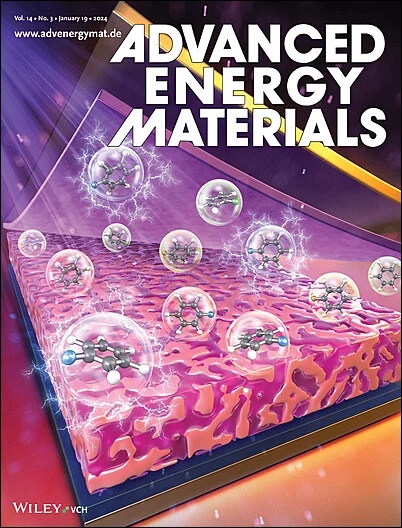协同铜合金在大电流制氢中缓解H*位点阻塞
IF 26
1区 材料科学
Q1 CHEMISTRY, PHYSICAL
引用次数: 0
摘要
工业碱性水裂解需要具有成本效益的析氢反应(HER)电催化剂,可以平衡H2O, H*和OH*的吸附。尽管NiMo合金具有强大的水吸附/解离作用和适度的H*吸附,但由于OH*的竞争性吸附会导致H*位点阻塞,从而阻碍了Volmer步骤并需要较大的过电位。在这里,通过铜合金化将NiMoCu催化剂结合到不锈钢网(SSM)上,开发了一种集成电极设计。优化后的NiMoCu在175 mV过电位下电流密度可达500 mA cm−2,分别比NiMo和Pt/C高19.5倍和6.9倍。原位表征和理论计算表明,分离H*和OH*吸附位点(H*为Ni─Cu, OH*为Mo)有效地减轻了H*位点阻塞。这种分离优化了各种中间体的短程吸附,从而提高了从Volmer到Heyrovsky步骤的动力学。此外,SSM支架的规则三维微米级结构促进了长距离传质,进一步提高了整体性能。当与NiFe LDH配对用于阴离子交换膜(AEM)水分解时,NiMoCu(-)||NiFe LDH(+)电解槽在1.98 V下提供2 A cm - 2,具有强大的耐用性。该策略可扩展到NiMoCo和NiMoZn催化剂,为高效制氢提供了一种通用方法。本文章由计算机程序翻译,如有差异,请以英文原文为准。
H* Site‐Blocking Alleviated Through Collaborative Copper Alloying for Large‐Current Hydrogen Production
Industrial alkaline water splitting requires cost‐effective hydrogen evolution reaction (HER) electrocatalysts that can balance the adsorption of H2 O, H*, and OH*. Despite robust water adsorption/dissociation and moderate H* adsorption, NiMo alloys are plagued by competitive OH* adsorption, which induces H* site‐blocking, thereby impeding the Volmer step and necessitating large overpotentials. Here, an integrated electrode design is developed by incorporating NiMoCu catalysts onto a stainless‐steel mesh (SSM) through Cu alloying. The optimized NiMoCu achieves a current density of 500 mA cm−2 at only 175 mV overpotential, nearly 19.5 and 6.9 times higher than NiMo and Pt/C, respectively. In situ characterizations and theoretical calculations reveal that segregating H* and OH* adsorption sites (Ni─Cu for H* and Mo for OH*) effectively mitigates H* site‐blocking. This segregation optimizes the short‐range adsorption of various intermediates, thereby enhancing the kinetics from Volmer to Heyrovsky step. Moreover, the regular 3D micrometer‐scale structure of SSM support promotes long‐range mass transfer, further improving the overall performance. When paired with NiFe LDH for anion‐exchange‐membrane (AEM) water splitting, the NiMoCu(−)||NiFe LDH(+) electrolyzer delivers 2 A cm−2 at 1.98 V, with robust durability. This strategy is extendable to NiMoCo and NiMoZn catalysts, offering a universal approach for efficient hydrogen production.
求助全文
通过发布文献求助,成功后即可免费获取论文全文。
去求助
来源期刊

Advanced Energy Materials
CHEMISTRY, PHYSICAL-ENERGY & FUELS
CiteScore
41.90
自引率
4.00%
发文量
889
审稿时长
1.4 months
期刊介绍:
Established in 2011, Advanced Energy Materials is an international, interdisciplinary, English-language journal that focuses on materials used in energy harvesting, conversion, and storage. It is regarded as a top-quality journal alongside Advanced Materials, Advanced Functional Materials, and Small.
With a 2022 Impact Factor of 27.8, Advanced Energy Materials is considered a prime source for the best energy-related research. The journal covers a wide range of topics in energy-related research, including organic and inorganic photovoltaics, batteries and supercapacitors, fuel cells, hydrogen generation and storage, thermoelectrics, water splitting and photocatalysis, solar fuels and thermosolar power, magnetocalorics, and piezoelectronics.
The readership of Advanced Energy Materials includes materials scientists, chemists, physicists, and engineers in both academia and industry. The journal is indexed in various databases and collections, such as Advanced Technologies & Aerospace Database, FIZ Karlsruhe, INSPEC (IET), Science Citation Index Expanded, Technology Collection, and Web of Science, among others.
 求助内容:
求助内容: 应助结果提醒方式:
应助结果提醒方式:


